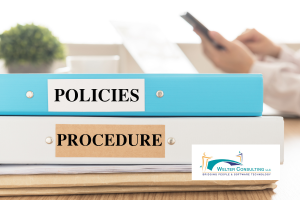
When was the last time you updated your organization’s Policies and Procedures manual?
Wait … you don’t have one?
The importance of a Policies and Procedures manual cannot be underestimated. P & P documents help your organization with communication, clarity, and compliance. Without a written manual accessible by all employees, you run the risk of confusion (at best) and legal action against your organization (at worst) for gray areas. Here’s what should go into a P&P manual and how to get started.
Dedicate Time and Effort to Creating the Manual
One thing that often gets in the way of an organization completing and issuing their Policies and Procedures manual is simply time. With budgets stretched thin and staff stretched equally as thin, it’s hard to find the right person to craft the manual or the budget to hire someone to do so.
Look within your human resources or operations teams to begin work on a Policies and Procedures manual. Employees in these departments may have worked on a similar document in a previous company and know what should be included.
If you need a consultant to create one, look for a freelancer or independent contractor who focuses on human resources documentation. Be sure to have someone knowledgeable in the legal and HR requirements included in the manual review of their work.
Start with Existing Documents
To begin the process of creating a Policies and Procedure manual, start with the existing documents at your organization. Such documents may include:
- Vacation, sick, and paid time off
- Holiday schedules
- Work-related guidelines, such as use of equipment
- Computer and IT documents
- Others
Gather these documents into one place while you assemble your team.
Brief the Team
Brief the team working on the manual to ensure a shared understanding of why they are working on the manual, the goals, and the process. Then, create a timeline with roles and responsiblities outlined, sections each person should focus on, and deadlines.
What to Include
What to include in your organization’s Policies and Procedures manual may vary from company to company. Ask the board, trustees, staff, consultants, and legal counsel for their input.
As you develop your plan, consider the areas of risk facing your organization. Do you face legal risks from working with the public? Hosting events? Dealing with healthcare issues? Maintaining privacy and confidentiality of constituents facing challenging issues such as mental health, physical health, or other needs? Each item must be addressed in the P & P manual.
Some general areas common to most Policies & Procedures manuals include:
- Employment procedures from hiring to voluntary or involuntary termination
- Cash/Accounting procedures such as how to handle revenue, etc.
- Cybersecurity, device policies, and remote work policies
- Vacation and paid time off policies
- Payment procedures
- Code of Conduct
- Internal Controls
- Other areas specific to your organization
As you put together a Policies & Procedures manual, a few considerations:
- Clear organization and structure of the final manual is essential. A logical sequence of information, good design with clear headlines, and a searchable index for digital documents is essential to help people find the information they need quickly.
- Minimize heavy blocks of text. Use headlines, subheadlines, and bullet points as much as possible.
- Better still, use graphics, if possible, to ensure full understanding of the information. Financial policies often benefit from simple workflow graphics to demonstrate how information, resources, or financial materials flow through a system.
Accessibility
Once the final manual is complete, it is a smart idea to have your legal counsel review the final draft. They may be able to suggest edits that clarify areas or add to policies to enhance clarity and compliance.
Lastly, ensure the final document is always accessible to all employees. Keep a link to the digital document prominent, such as on the HR Portal or bookmarked on a company intranet. Employees should never have to hunt for the manual that guides their work. The easier it is to find and use, the better.




Recent Comments